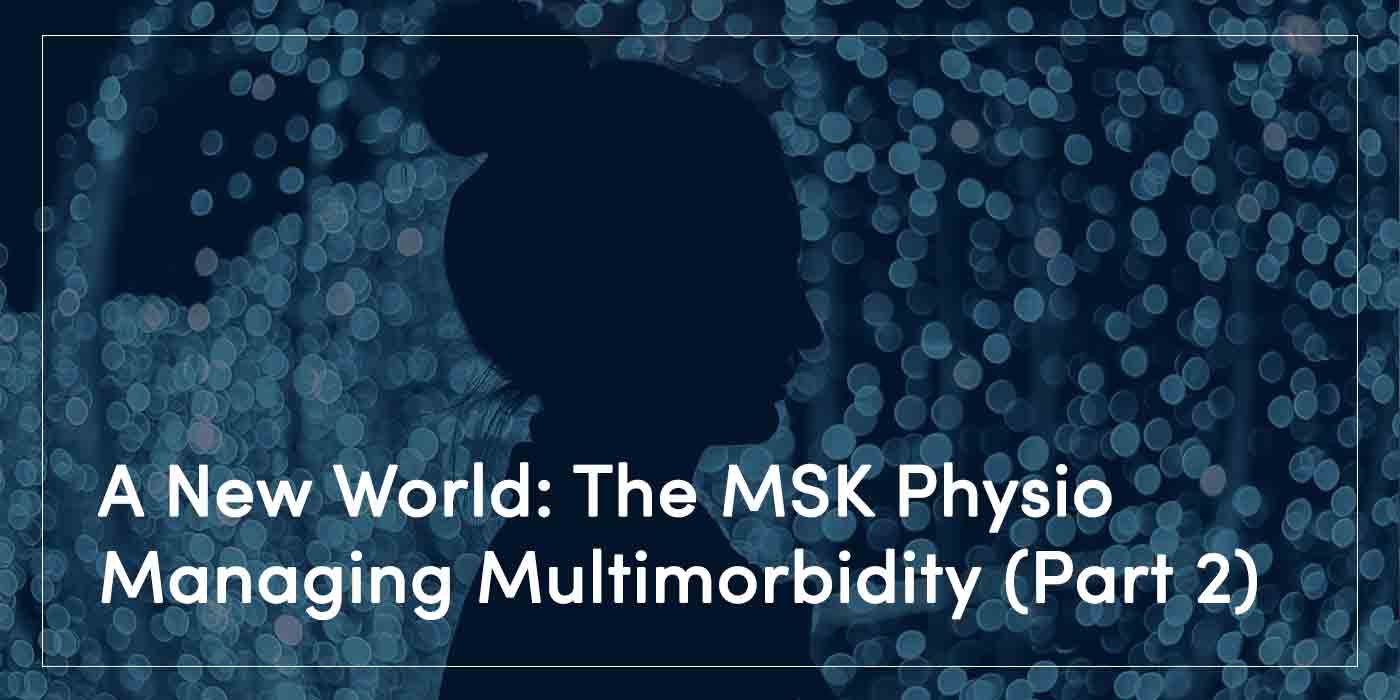Part Two: A New World – The MSK Physio Managing Multimorbidity

The second in this three-part series looks at how we might think differently about where MSK rehabilitation/physiotherapy views its role in multimorbidity. This piece follows our presented case further into rehabilitation.
What we initially presented was the premise that as MSK is now within the six major
conditions strategy, and we know that patients with a long term MSK pain/disorder are likely to be combatting other medical problems, we asked: how can we adapt our approach to accommodate this?
MSK Physio Assessment
Let’s look firstly at the assessment in more detail. In many cases the MSK physiotherapist will choose to look closely at the pain that the patient is presenting with. They will try to create a “picture”, so to speak, to help with the clinician’s reasoning; assessing how the pain behaves, its impact and then whether these could be measurable markers to help in understanding change.
The patient understandably will want this as the pain in many cases is the reason for seeking help and support. The clinician takes a note of the past medical history and medication and commonly this is listed and perhaps there will be some reference to safety issues within the information that the clinician should be aware of, such as red flags or a history that could affect rehabilitation outcomes.
Taking a Broader Approach
In this new world, the focus shifts into a more function, lifestyle, and multimorbidities review that encompasses the restriction to activity and life functions and engages all those factors that could be causing this, for example breathlessness in COPD.
This would inherently affect how an individual engages in exercise, and the question is: would the MSK physiotherapist engage an exercise plan to cater for this and the issues in the MSK system collaboratively?
Some may, some may not, but inherently it’s likely seen as a separate issue. If the
rehabilitation unit looked after the pulmonary rehab side of things within a broader activity and exercise accommodated approach, it wouldn’t matter and it would be brought squarely into the clinical reasoning.
Rather than over-focus on pain limiting factors, the physiotherapist switches to function across all the physical limitations. Pain clearly is a limiting factor and has to be part of the conversation, but the patient would be aware that the focus of the session is to look beyond that and gain a better understanding into significant lifestyle changes across all their conditions that can be helped by activity.
Challenge of Population Health
Why when activity and exercise are so important in so many non-communicable diseases do patients see numerous
physiotherapists with “special interests” when the “special interests” could be activity and exercise across the range of limitation and perhaps could see one clinician for it all?
We still need the orthopaedic, neuro, respiratory specialist teams, but this should be seen as the minimum, dealing with complexity, when the maximum challenge is population health which as a profession we can impact on in multiple ways without handover.
Imagine as a physiotherapist being the specialist in activity and exercise and that being the valued marker in equal measures as knowledge of specific areas of the body?
Rehabilitation can be redefined and this concept is not new. Across the world where physiotherapists use their range of skills to serve a population and we see this in practice because the health systems do not need specialists in one joint, it’s not economically viable, and the workforce is not available.
Rather than assuming this is a backward model, perhaps countries that utilise physiotherapists across all their skillssets have something we can learn from?
Over-focus on Specialist Areas
Is the over-focus on specialist areas of MSK practice that are linked to a joint or body part negatively affecting some to the fact that patients live with a multitude of problems that needs a joined-up model?
The continuation of regarding that something is “special” because an individual knows or has a lot of interest in it does not actually mean it will translate into a measurable positive impact other than managing a waiting list or improving the patient flow through a system.
There has been good evidence for the benefit of specialism in some areas, but in terms of numbers, this is relatively small.
Moving away from thinking how we improve an orthopaedic pathway needs the alternative: that we embed practice in the community within a multimorbidity, long term conditions management plan that offers the broader approach that this population needs.
The final instalment of our three-part series will look at how we might start to challenge this within practice education at the very start of careers.